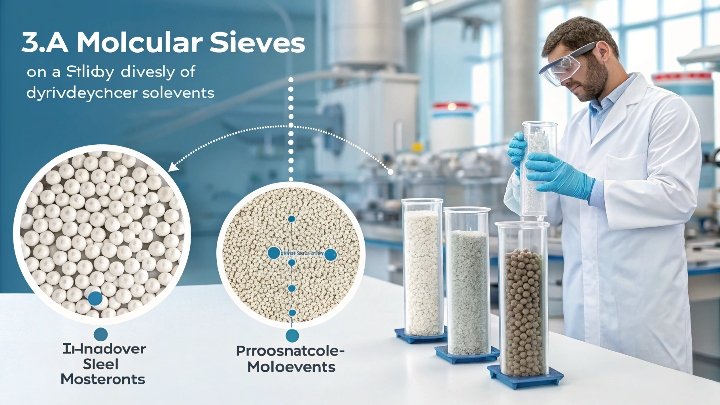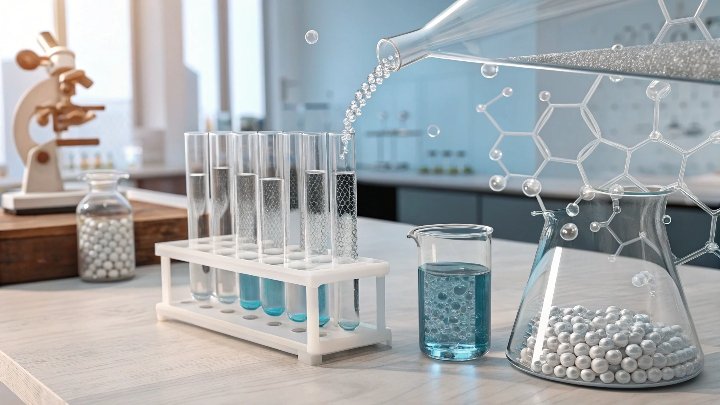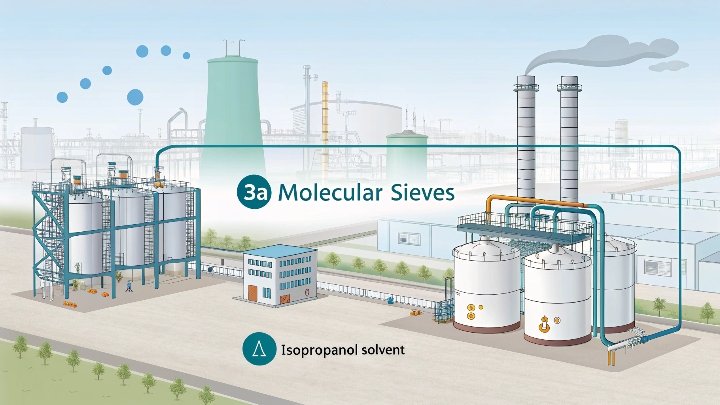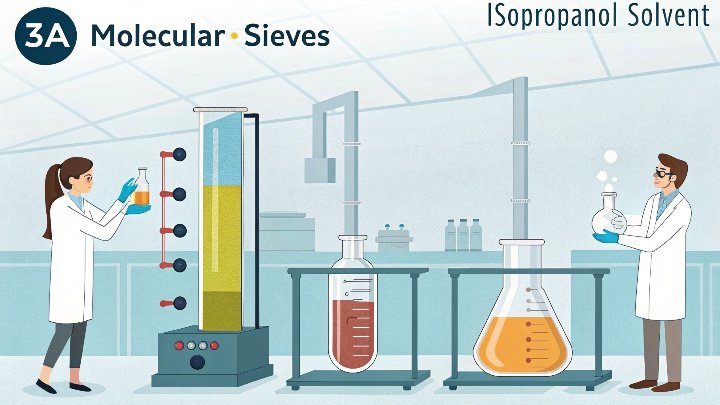Are you tired of moisture wrecking your isopropyl alcohol purity? I know the frustration. I have a practical solution that ends your drying challenges.
3A molecular sieve is the top choice for drying isopropyl alcohol. It has uniform pore size and a large surface area. It selectively adsorbs water molecules. This helps achieve high-purity isopropyl alcohol without extra contaminants.
I want you to see why 3A molecular sieve is so powerful. Please keep reading.
The Magic of 3A: Why This Molecular Sieve Reigns Supreme for Isopropyl Alcohol Drying?
Do you face trouble removing water from your isopropyl alcohol? This question bothered me too. I found a practical fix that changes the game.
3A molecular sieve stands out because it targets water molecules. Its pore size is optimal for removing water. It avoids bigger molecules. This keeps valuable solvents intact.
Pore Structure
3A molecular sieve has pore openings of around 3 angstroms. This size excludes many larger molecules but grabs water. This helps me maintain the composition of isopropyl alcohol. I rely on 3A to keep only water locked inside while letting the other molecules pass. That is why I consider it the champion for dryness.
Adsorption Mechanism
3A molecular sieve uses physical adsorption to catch water molecules. The high surface area pulls in water. The uniform pore size ensures that water fits snugly. This is a selective process. The result is consistent dryness. I have seen how 3A cuts production delays. Once water is adsorbed, the sieve can be regenerated. That means it can be heated to drive water out, then reused. That helps reduce waste and cost.
My Personal Story
I once struggled with subpar isopropyl alcohol. Water contamination spoiled my final products. Then I tried 3A molecular sieve. My results improved quickly. My water levels dropped. My product purity went up. This helped me fulfill strict quality standards. I felt confident selling a better product. My team was relieved. We also saw fewer process interruptions and better yields.
Now I lean on 3A molecular sieve whenever I handle isopropyl alcohol. It spares me from extra worry about excess moisture. It also keeps my operating costs stable.
| Molecular Sieve | Pore Size (Å) | Primary Use |
|---|---|---|
| 3A | 3 | Water removal from polar solvents |
| 4A | 4 | General drying of gases and liquids |
| 5A | 5 | Separation of normal and isomeric HC |
3A molecular sieve is not just a random product. It is my trusted ally for isopropyl alcohol dehydration. When I use it, I see real improvements in product purity. That is why I consider it the top choice for any process that needs tight moisture control.
Beyond the Basics: Exploring the Science Behind Molecular Sieve Drying?
Are you uncertain about how molecular sieves remove water so well? I was once unsure too. I want to show you the science behind it.
Molecular sieve drying happens through adsorption. The sieve captures water molecules on its surface and within its pores. This process is not simple. It involves physical forces and precise pore sizes.
Adsorption vs Absorption
Many people confuse adsorption with absorption. Adsorption happens when molecules adhere to a surface. Absorption involves the full volume of a material. I learned that difference when I first started working with molecular sieves. I saw how the sieve only held water on its exterior and in its pores. It did not soak water like a sponge. That distinction helped me understand the real nature of molecular sieve drying.
Role of Selective Pore Size
Molecular sieve pores have specific dimensions. In the case of 3A, those pores measure about 3 angstroms. Water fits easily inside. Larger molecules do not fit. This leads to selective adsorption. It is the reason isopropyl alcohol stays almost untouched. The water is pulled away, leaving the isopropyl alcohol behind. I find this feature crucial for preserving the solvent’s purity and character. If the pore size was bigger, we could lose valuable molecules. If it was smaller, water might not pass. That is the magic of a well-crafted sieve.
Regeneration Steps
Molecular sieves can be used again. We remove water by heating. That changes the equilibrium. Water molecules release from the sieve surface. Then the sieve is ready for another cycle. I sometimes do multiple cycles in a day. This saves me money and reduces waste. It also gives me confidence that my production line runs smoothly. I do not need to purchase new sieve material every time. That reliability has made a big impact on my process economics.
| Factor | Impact on Drying |
|---|---|
| Pore Size | Determines which molecules fit |
| Heating Method | Affects regeneration speed |
| Adsorbent Surface Area | Influences water uptake |
These scientific details shape the performance of molecular sieve drying. I have applied these ideas in many settings. They help me solve problems tied to moisture. Understanding adsorption, pore size, and regeneration steps lets me optimize my approach. I achieve better yields, fewer process issues, and higher product purity. That is the core of molecular sieve drying science for me.
Practical Applications: Putting Molecular Sieves to Work in the Real World?
Do you wonder if molecular sieves fit your industrial process? I used to doubt that too. Let me show you how they help in real-life scenarios.
Molecular sieves work in distilleries, chemical plants, and laboratory setups. They remove unwanted water from various solvents. They help produce consistent results. They also extend equipment life by preventing corrosion. This is how I achieve reliable performance across many processes.
Industrial Settings
I have witnessed molecular sieves used in large chemical plants. Companies need high-purity solvents for manufacturing pharmaceuticals and specialty chemicals. Water can spoil reactions or slow production lines. With 3A molecular sieve, they remove moisture and gain better consistency. I have also seen big distilleries rely on molecular sieves for final drying steps. This helps them produce consistent alcohol content. By removing water, they maintain product uniformity. The process is straightforward but yields big improvements.
Laboratory and Research Uses
In research labs, small-scale drying of solvents is critical. Water can ruin tests or alter analytical results. I remember a time when I was running an experiment on solvent reactivity. Water traces created unexpected side products. Then I switched to a setup that included 3A molecular sieve. My data improved. The final results were clear. Many labs keep molecular sieves on hand for quick solvent drying. This saves time and keeps data reliable.
Troubleshooting Common Issues
Sometimes, molecular sieves can lose efficiency. This can happen if the sieve is not properly regenerated. Dirt or oils can also block the pores. I always remind colleagues to handle sieves with care. We keep them in sealed containers when not in use. We follow recommended regeneration temperatures to keep them effective. If contamination does occur, we do careful cleaning or replace the sieve. That ensures consistent adsorption performance. Another challenge is selecting the right pore size. If you pick a bigger pore, you might adsorb unwanted components. If you pick a smaller pore, you might not remove enough water. I learned to run small tests before scaling up. That approach saved me from costly mistakes.
| Application | Benefit |
|---|---|
| Industrial solvent drying | Improves product consistency |
| Distilleries | Maintains alcohol concentration |
| Laboratory experiments | Produces accurate test results |
| Specialized chemical production | Reduces side reactions |
I see how molecular sieves solve many moisture-related problems. They protect equipment, ensure steady production, and save costs. For me, they are a key part of a reliable process. I trust them for my own manufacturing tasks, and I have seen them empower industries of all sizes.
Conclusion
I see 3A molecular sieve as my top tool for isopropyl alcohol drying. It offers reliable water removal, longer usage life, and consistent purity levels.






